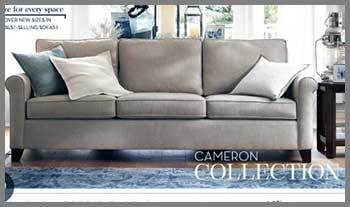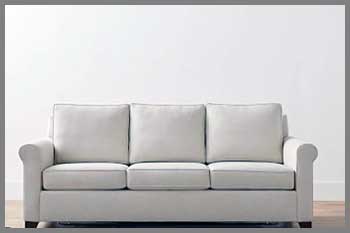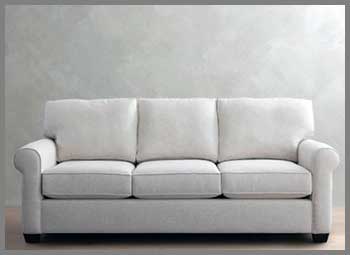
Picture this: you’re sinking into a plush, stylish sofa that feels like a warm hug after a long day.
That’s the Pottery Barn Cameron Sofa, and I’m here to tell you why it’s worth every penny.
With its timeless design, durable construction, and endless customization options, it’s a game-changer for any living space.
Whether you’re a busy parent, a pet lover, or just someone who craves comfort with a touch of elegance, this sofa delivers.
Join me as I share my experience, break down the pros and cons, and compare it to other brands to help you decide.
My Experience With Pottery Barn Cameron Sofa
When I first laid eyes on the Pottery Barn Cameron Sofa, I was smitten. I’d been hunting for a sectional to fit my cozy condo, and after months of scrolling online and testing showroom models, the Cameron caught my attention with its clean lines and inviting vibe.
I ordered the 3-piece sectional in Sunbrella Performance Basketweave fabric, hoping it would stand up to my two rambunctious kids and a shedding golden retriever. Spoiler alert: it’s been a dream.
The delivery process was smooth as butter. Pottery Barn’s white-glove service meant two friendly guys showed up right on time, assembled the sofa in my living room, and hauled away the packaging. It took about 20 minutes, and I didn’t lift a finger.
The sofa fit perfectly in my space, measuring 108 inches wide and 38 inches deep, with a low profile that didn’t overwhelm my room. I chose the oatmeal color, which added a warm, neutral glow to my modern decor.
Sitting on it feels like sinking into a cloud, but with just enough support to keep you from feeling swallowed. My husband, who’s 6’2”, loves stretching out on the chaise without his feet dangling off. The kids have turned it into their personal playground, and the dog claims it as his napping throne.
I was nervous about the light fabric, but the Sunbrella material has been a lifesaver. A juice spill from my toddler? Wiped away with a damp cloth. Dog hair? A quick vacuum, and it’s gone. After a year, it still looks fresh, though I’ve noticed the cushions need occasional fluffing to keep their shape. It’s not perfect—more on that later—but it’s become the heart of our home.
Read more: My Thoughts on Gemcore Flooring
Pros Of Pottery Barn Cameron Sofa

- Customization Galore:
You can tailor the Cameron to your exact needs with over 100 fabric options, from durable Sunbrella to luxurious leather. I went with performance fabric for my chaotic household, but you can pick colors and textures to match any aesthetic, whether it’s coastal chic or urban modern.
- Sturdy Construction:
The kiln-dried hardwood frame feels solid, and the steel springs provide excellent support. I’ve had friends comment on how well-built it feels compared to cheaper sofas they’ve owned. It’s designed to last, and after a year of heavy use, I can vouch for its durability.
- Comfort That Hits The Sweet Spot:
The down-blend cushions strike a perfect balance between plush and supportive. Whether you’re binge-watching a series or hosting a game night, you won’t want to get up. My back feels great even after hours of lounging.
- Easy To Clean:
The Sunbrella fabric is a godsend for messy households. Spills and stains wipe off with minimal effort, and the slipcover option means you can toss it in the wash for a full refresh. I’ve cleaned everything from crayon marks to pet accidents without a hitch.
- Timeless Design:
The Cameron’s boxy, roll-arm style is classic yet versatile, blending seamlessly with traditional or contemporary decor. It’s a piece that won’t go out of style, and I love how it elevates my living room without screaming “trendy.”
Cons Of Pottery Barn Cameron Sofa
- Pricey Investment:
Let’s be real—this sofa isn’t cheap. My sectional set me back about $3,500, even during a 25% off sale. If you’re on a tight budget, you might wince at the price tag, especially when you factor in delivery fees.
- Long Lead Times:
I waited 12 weeks for delivery, which tested my patience. Pottery Barn’s made-to-order process means you’re not getting instant gratification. If you need a sofa ASAP, this might not be your best bet.
- Cushion Maintenance:
The down-blend cushions are cozy but require regular fluffing to avoid looking lumpy. I spend a few minutes every week rearranging them, which can feel like a chore if you’re not used to it.
- Armrest Comfort:
The armrests are a bit firm for my taste. My kids don’t mind, but I wish they had more padding for when I’m curled up reading. It’s a minor gripe, but worth noting if you love resting your arms.
- Limited Warranty:
Pottery Barn offers a 30-day return policy but no formal warranty on furniture. If something goes wrong after a year, you’re on your own. I haven’t had issues, but the lack of coverage makes me a bit nervous.
Maintenance Tips For Pottery Barn Cameron Sofa

- Regular Vacuuming:
Dust and pet hair can settle into the fabric, so I vacuum my Cameron weekly using a brush attachment. It keeps the sofa looking fresh and prevents dirt from embedding, especially in high-traffic areas like the seat cushions.
- Spot Cleaning Spills:
For stains, I dab (never rub!) with a damp cloth and mild soap. Sunbrella fabrics are forgiving, but quick action is key. I’ve tackled everything from wine to muddy paw prints, and the sofa still looks pristine.
- Fluffing Cushions:
To maintain that plump, inviting look, I fluff the cushions every few days. Flip them, rotate them, and give them a good pat to redistribute the down filling. It’s a small effort for a big payoff.
- Washing Slipcovers:
If you opt for a slipcovered Cameron, follow the care label—mine says cold wash, air dry. I use a handheld steamer to smooth out wrinkles after washing, which keeps the sofa looking tailored and sharp.
- Protect From Sunlight:
Direct sunlight can fade even performance fabrics over time. I positioned my sofa away from windows and use curtains to block UV rays, ensuring the oatmeal color stays vibrant.
Also read: My Thoughts on Lux Flooring
Comparison With Other Brands
- Arhaus Kipton Sofa
I considered the Arhaus Kipton before settling on the Cameron, drawn to its handcrafted appeal and solid wood construction. Arhaus emphasizes eco-friendly materials, and the Kipton’s plush cushions rival the Cameron’s comfort. However, it’s pricier, often starting at $4,000, and customization options are more limited, with fewer fabric choices. The Kipton’s artisanal vibe is stunning, but its deeper seat depth (40 inches) felt too sprawling for my condo. Arhaus offers a warranty, which Pottery Barn lacks, but their delivery times can stretch even longer, sometimes up to 16 weeks. If you prioritize craftsmanship and don’t mind the cost, the Kipton is a strong contender, but the Cameron’s versatility won me over.
- West Elm Harmony Sofa
West Elm’s Harmony Sofa caught my eye for its modern, low-profile design and more budget-friendly price, starting around $2,000. Its foam cushions are firmer than the Cameron’s down-blend, which some might prefer for less maintenance. However, the fabric options (around 50) pale in comparison to Pottery Barn’s 100-plus choices, and the frame felt less substantial in showrooms. West Elm’s sustainability focus is a plus, but I noticed their fabrics pilled more easily under heavy use. For a sleek, affordable option, the Harmony is great, but it doesn’t match the Cameron’s durability or classic style.
- Crate & Barrel Lounge II Sofa
The Crate & Barrel Lounge II Sofa was another option I tested, with its deep seats and casual vibe. Priced around $2,500, it’s a bit cheaper than the Cameron, and its feather-filled cushions are cozy. However, the frame is made of engineered wood, which feels less sturdy than the Cameron’s hardwood. Fabric options are decent but limited to about 60 choices, and the slipcovers aren’t as easy to clean as Sunbrella. Delivery was faster (about 8 weeks), but the overall build quality didn’t inspire the same confidence. If you want a relaxed look, it’s solid, but the Cameron feels more refined.
- Ashley Furniture Zardoni Sofa
For a budget option, I looked at the Ashley Furniture Zardoni Sofa, priced around $800. It’s a steal, but the polyester upholstery and foam cushions don’t hold a candle to the Cameron’s premium materials. The Zardoni’s frame is also engineered wood, and after sitting on it, I could tell it wouldn’t withstand my family’s daily chaos. Customization is minimal, with only a few color options, and the comfort level felt basic. Ashley’s quick delivery (2-4 weeks) is a plus, but for long-term durability, the Cameron is a much better investment.
Frequently Asked Questions (FAQ)
From my experience, Pottery Barn sofas, like the Cameron, are high quality. The hardwood frame, steel springs, and performance fabrics like Sunbrella make them durable and stylish. Customer reviews often praise their longevity, with some reporting sofas lasting 10-15 years with proper care. However, quality can vary by model, and newer versions may not match the sturdiness of older ones, as some users note declining standards. Compared to budget brands, Pottery Barn’s construction is superior, but the lack of a warranty is a drawback.
It’s tough to crown one brand, but Arhaus stands out for its handcrafted, solid wood furniture, often lasting over a decade with heavy use. Pottery Barn competes closely with its durable frames and premium fabrics, as does Ethan Allen for heirloom-quality pieces. For budget-friendly options, West Elm and Crate & Barrel offer solid construction but may not match the longevity of high-end brands. My Cameron holds its own, but if you’re after artisanal craftsmanship, Arhaus might edge out slightly.
A Pottery Barn sofa like the Cameron should last 7-15 years, depending on use and maintenance. High-end models with down-blend cushions and hardwood frames, like mine, lean toward the longer end with regular care. Leather versions can hit 20 years, as they’re easier to maintain. My sofa’s held up beautifully after a year, and reviews suggest similar models stay strong for a decade or more, though heavy use by kids or pets might shorten that slightly.
Pottery Barn sofas are made by Williams-Sonoma, Inc., their parent company since the 1980s. Manufacturing often happens in the U.S. for higher-end models, though some components or fabrics may be sourced globally. Exact factory details are tough to pin down, as Pottery Barn doesn’t disclose specific partners. My Cameron’s quality suggests domestic production, but some online forums mention overseas manufacturing for certain fabrics, so it varies by model and customization.
Conclusion: For Pottery Barn Cameron Sofa
If you’re searching for a sofa that marries style, comfort, and durability, the Pottery Barn Cameron Sofa is a fantastic choice. Its customizable design, sturdy build, and easy-to-clean fabrics make it ideal for busy households or anyone who loves timeless elegance.
Despite the high price and longer wait times, the investment pays off with years of cozy moments. I’ve loved every second on mine, and I’m confident you will too. Make your living room a haven—grab a Cameron during the next sale!
